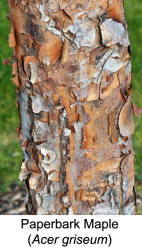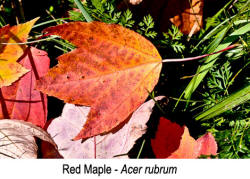Sure, flowers are beautiful. They are
exactly what most people associate with gardening. In
fact, the common term is “flower beds and borders” which
seems to disregard all the other points of interest to
be found in them.
A simple rule is that, whenever you can find a plant
that meets your major design criteria but also adds
interest in other ways, you have a bonus. For most of
our plants, flowers are the key factor followed a bit
behind by foliage color or texture. However, many, many
plants will reward us with multiple points of interest.
 A. Bark Texture - The bark on certain trees such as the
Kousa dogwood (Cornus
kousa), Sycamore (Platanus
occidentalis), paperbark maple (Acer
griseum), several birches (Betula)
and others add an interesting touch. Most of these have
what is called exfoliating bark which means that small
sections fall off revealing other colors below. Bark may
also have a textural contrast from smooth, gray bark of
the
beech to coarse texture of the hickory tree.
A. Bark Texture - The bark on certain trees such as the
Kousa dogwood (Cornus
kousa), Sycamore (Platanus
occidentalis), paperbark maple (Acer
griseum), several birches (Betula)
and others add an interesting touch. Most of these have
what is called exfoliating bark which means that small
sections fall off revealing other colors below. Bark may
also have a textural contrast from smooth, gray bark of
the
beech to coarse texture of the hickory tree.
B. Fall Color - Fall color is a primary way that many
tree and shrub species extend their ornamental season.
The dogwoods generally have a show of reddish to purple
leaves in the fall. Of course the maples are noted for
their displays especially by the sugar maple (Acer
saccharrum) and red maple (Acer
rubrum) species. Several viburnum (Viburnum)
species of shrubs also display good, reddish fall color.
There are many more plants with fall color available so
do a little research to find ones that fit into your
design.
C. Fruit and Seeds - Fruit is yet another way of adding a
secondary
 ornamental display. Hollies (Ilex)
may be tops on the list in this category although there
are many others including crabapples (Malus),
firethorn (Pyracantha),
etc. Remember, that to have fruit on certain plants such
as the hollies, you will need to have both a male and a
female plant in close proximity.
ornamental display. Hollies (Ilex)
may be tops on the list in this category although there
are many others including crabapples (Malus),
firethorn (Pyracantha),
etc. Remember, that to have fruit on certain plants such
as the hollies, you will need to have both a male and a
female plant in close proximity.
The seed heads of
ornamental grasses will extend the season well into
and through the winter.



